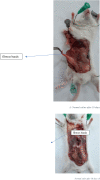Effect of intra-peritoneal induction of ascites fluid on the rate of postoperative intraabdominal adhesion in a rat model
- PMID: 36045826
- PMCID: PMC9422052
- DOI: 10.1016/j.amsu.2022.104129
Effect of intra-peritoneal induction of ascites fluid on the rate of postoperative intraabdominal adhesion in a rat model
Abstract
Introduction: Intra-abdominal adhesions (IAAs) are secondary to peritoneal injuries such as previous surgery or intra-abdominal infections (IAIs). Accordingly, it is crucial to employ fitting techniques to minimize the likelihood of adhesions in any surgery. Due to a paucity of similar data available, this study sought to explore the effects of induced high serum ascites albumin gradient (SAAG) and low serum ascites albumin gradient (SAAG) on the rate of post-operative microscopic and macroscopic adhesion in a mouse model.
Material and methods: Sixty mice were compared in six groups of ten each. Control groups (1 &4) received normal saline, groups 2&5 received high SAAG ascites fluid, and groups 3&6 received low SAAG ascites fluid intraperitoneally. These groups underwent exploratory laparotomy on day zero, followed by the same procedure on the 10th (groups 1,2,3) and the 30th (Groups 4,5,6) day of surgery. Then, microscopic and macroscopic IAAs were evaluated. Data were analyzed in SPSS software and compared with a p-value less than 0.05.
Results: By comparison, the least microscopic and macroscopic IAAs after 10 and 30 days were found in the low SAAG ascites group. Revealing a statistically significant difference compared to the other two groups (P = 0.01). After 10 days of surgery, macroscopic IAA in the high SAAG group was significantly lower compared to the control and Low SAAG ascites groups.
Conclusion: Intraabdominal low SAAG ascites fluid can significantly decrease the probability of postoperative fibrosis and adhesion band formation.
Protocol number: IR. BUMS.REC.1399.503.
Keywords: Ascites fluid; High SAAG; Intra-abdominal adhesions (IAA); Low SAAG.
© 2022 Published by Elsevier Ltd on behalf of IJS Publishing Group Ltd.
Conflict of interest statement
The authors declare no competing interest.
Figures





References
-
- Bunicard F.C.A.D., Bihhiav T.R., Dunn D.L., Hunter J.G., Mathews J.B., Pollack . The McGraw-Hill Company; 2015. Schwartz Principles of Surgery 2015. Schwartz Principles of Surgery 2015; p. 224.
-
- Tingstedt B., Isaksson K., Andersson E., Andersson R. Prevention of abdominal adhesions–present state and what's beyond the horizon? Eur. Surg. Res. 2007;39(5):259–268. - PubMed
-
- Okabayashi K., Ashrafian H., Zacharakis E., Hasegawa H., Kitagawa Y., Athanasiou T., et al. Adhesions after abdominal surgery: a systematic review of the incidence, distribution and severity. Surg. Today. 2014;44(3):405–420. - PubMed
-
- Penzias A., Bendikson K., Falcone T., Gitlin S., Gracia C., Hansen K., et al. Postoperative adhesions in gynecologic surgery: a committee opinion. Fertil. Steril. 2019;112(3):458–463. - PubMed
LinkOut - more resources
Full Text Sources

